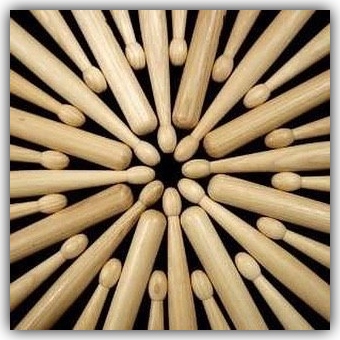

When you’re trying to find drumsticks that feel great to play, it is helpful to know the characteristics that affect their performance. Let’s take a look at the things that make the difference.
SIZE
There seem to be thousands of different stick sizes available. Also, most well-known drummers have their own modified custom signature sticks available through the company they endorse. The good news is that most sticks are variations of the basic categories below.
The main sizes have the numbers 7, 5, and 2; with the number getting smaller as the stick gets bigger (think small, medium, and large). So a 7 would be a small stick and a 2 would be a large stick. Each of these sizes also has a letter classification: “A” for acoustic or light playing, “B” for band (a little thicker), and “S” for street or marching (thickest).
Different sticks are suitable for different playing styles. For example, thin 7A sized sticks may be suitable for bebop jazz because of the fast, yet intricate, playing. Whereas 2Bs are heavier, thicker, and are used by harder-hitting rock players. 5Bs, which are the most versatile, fall between 2Bs and 5As. You can have different sized sticks for different playing situations. It is also worth noting that each manufacturer’s stick sizes may vary a little. So a 5B from one company could feel different than a 5B from another company.
These are just guidelines though. Whatever size feels right in your hands for your playing situation is what you should choose.
WOOD
The three main types of wood used to make most drumsticks are oak, hickory, and maple. Each differs in weight, density, and texture. Oak is the heaviest and darkest wood out of the three. Oak sticks are durable and usually last longer than sticks made of other types of wood. Hickory is probably the most popular wood for drumsticks and is lighter than oak. It is responsive and sturdy. Maple is a very light wood that allows for a larger diameter stick without the extra weight but is less durable. You can use the weight of different woods to your advantage. For example, if you like how a certain oak stick feels, but it’s a little too heavy, try that same size in hickory.
Some drummers prefer sticks made out of synthetic materials because of durability (the material is stronger than wood, therefore it lasts longer) and shock absorption (the shock of the impact on a cymbal or drum is reduced before it reaches the hands.)
SHOULDER
The length of the shoulder (where the stick starts to get skinny) affects how quickly the stick rebounds off of drums and cymbals. A long, narrow taper is fast and responsive. A short, quick taper feels front-heavy with less rebound.
TIP
The tip of the stick (what it’s made of and its shape) affects tone and articulation. Tips are made of either wood or nylon. Wood tips produce a warmer sound and nylon tips sound brighter and are more durable.
Round and barrel-shaped tips have a bright, clear tone while oval-shaped tips have a dark, warm tone. Teardrop and acorn-shaped tips produce a full rich tone while arrowhead-shaped tips have a light, sharp tone.
LENGTH
The length of the stick affects its leverage and reach around the drum set. The average size of a drumstick is about 16 inches long. Longer sticks tend to feel heavier.
FINISH
A stick’s finish affects its grip and feel. Lacquered sticks are smooth and help reduce blisters and chafing. An uncoated stick helps to improve gripping. (Some drummers use grip tape on the end of their sticks to improve the feel of their grip.)
SPECIALTY STICKS
For alternative sounds, you can use brushes or dowel rod type sticks. Brushes are wire or nylon strands attached to the grip handle of a drumstick. (Brushes have a playing technique all their own.) Dowel rods are bundles of wooden rods that produce a sound louder than brushes but not as loud as a regular stick. Also, mallets (sticks with a felt or yarn ball at the tip) produce a muted sound on the drums and are great for cymbal rolls.
HOW TO CHOOSE A STICK
Ideally, you want sticks that are identical, straight, and feel the same in each hand. Most drumsticks today are made with precise manufacturing methods but check to see that they are the same length and made of the same material. Check each drumstick for straightness by rolling the stick on a hard, flat surface. If the stick wobbles as you roll it, then it is not straight.
If you are new to drumming, don’t let all of this information confuse you. Overall, you just want a stick that feels comfortable and makes the sound you want. Since sticks will break over time and need to be replaced, feel free to try different models. Most music stores will let you try their sticks on a practice pad before you buy them. I hope this information helps you to choose the right stick for your playing situation.

